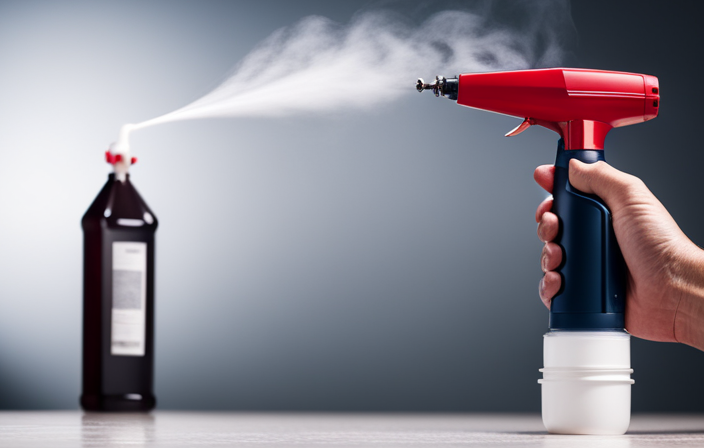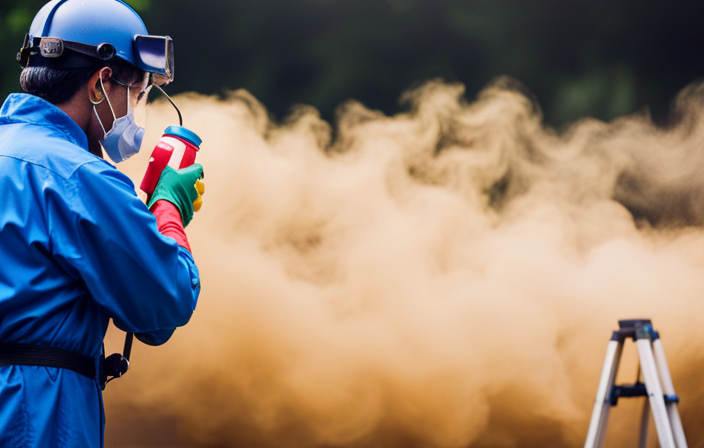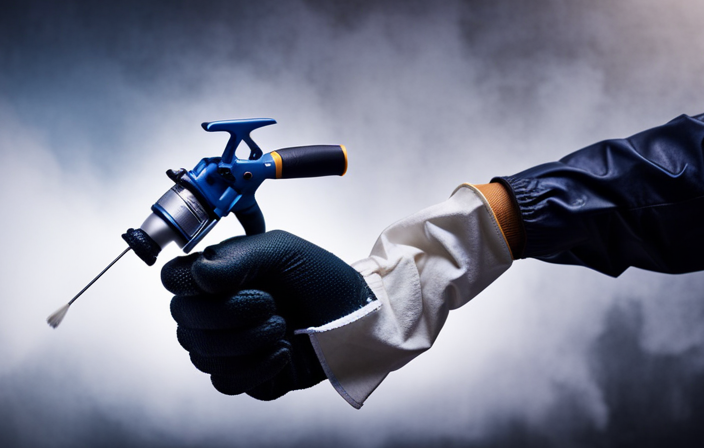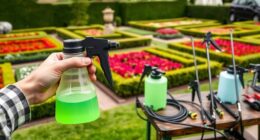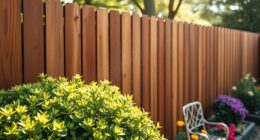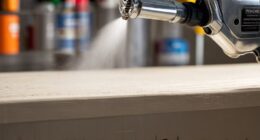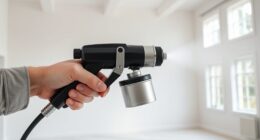So, you’ve purchased an airless paint sprayer, correct? It’s a great tool for handling large painting projects, isn’t it? But here’s the catch – in order to maintain your sprayer’s performance, it’s important to give it regular upkeep and proper care. This includes selecting the appropriate cleaning solution.
In this article, I’ll be diving into the world of airless paint sprayer cleaners. We’ll explore the different types of cleaners available, how to choose the right one for your sprayer, and the proper techniques for cleaning it. I’ll even throw in some maintenance tips and troubleshooting advice, just to make sure you’re covered from all angles.
Cleaning an airless paint sprayer may not be the most glamorous task, but it’s an essential one. So, let’s get down to the nitty-gritty and ensure that your sprayer stays in tip-top shape for all your future painting projects.
Key Takeaways
- Using the right cleaning solutions is crucial for airless paint sprayers.
- Read manufacturer’s instructions for any cleaning solution and ensure proper ventilation and protective equipment.
- Use cleaning solutions specifically designed for paint sprayers, such as mineral spirits or paint thinner.
- Clean the airless paint sprayer after each use or at least once a week, following the recommended cleaning methods and schedule for optimal performance and longevity.
Understanding the Importance of Cleaning an Airless Paint Sprayer
Understanding the importance of cleaning an airless paint sprayer is crucial for optimal performance and prolonging its lifespan. Regular cleaning prevents paint residue and contaminants from building up, which can lead to clogs, uneven spray patterns, and decreased efficiency. By removing leftover paint, cleaning filters, and flushing the system with the recommended cleaning solution, you can maintain consistent, high-quality paint application. Neglecting this maintenance can result in costly repairs or the need for a new sprayer altogether.
Now that you understand the importance of cleaning an airless paint sprayer, let’s explore the different types of cleaners you can use.
Types of Cleaners for Airless Paint Sprayers
To effectively maintain your airless paint sprayer, opt for various types of solvents and degreasers. This will allow you to effortlessly remove any lingering residue and restore its pristine condition.
Cleaning agents commonly used for airless paint sprayers include mineral spirits, denatured alcohol, and lacquer thinner. These solvents are effective in breaking down paint particles and removing them from the sprayer components.
Alternatively, you can also use water-based cleaners, such as soapy water or a mixture of vinegar and water. These options are eco-friendly.
When using cleaners, make sure to follow the manufacturer’s instructions and safety guidelines.
Regularly cleaning your airless paint sprayer not only ensures optimal performance but also extends its lifespan.
Now that we understand the types of cleaners available, let’s move on to choosing the right cleaner for your airless paint sprayer.
Choosing the Right Cleaner for Your Airless Paint Sprayer
When it comes to choosing the right cleaner for your airless paint sprayer, there are a few recommended products that can effectively remove paint residues and keep your sprayer in excellent condition.
One popular option is a water-based cleaner, which is environmentally friendly and safe to use. It can effectively clean water-based paints and is easy to rinse off.
Another choice is a solvent-based cleaner, which is more powerful and suitable for heavy-duty cleaning. It can effectively remove oil-based paints and stubborn residues.
Additionally, there are specific cleaning solutions designed for different types of paint, such as latex or oil-based. These cleaners are formulated to tackle specific paint types and can provide better results.
By choosing the right cleaner for your airless paint sprayer, you can ensure thorough cleaning and prevent clogging or damage. Proper cleaning techniques for an airless paint sprayer will be discussed in the next section, ensuring its longevity and peak performance.
Proper Cleaning Techniques for an Airless Paint Sprayer
Take a moment to master the essential cleaning techniques that’ll keep your airless paint sprayer in top-notch condition, ensuring flawless performance every time.
When it comes to airless paint sprayer maintenance, following best practices for cleaning is crucial. Here are some precise and detailed steps to help you clean your airless paint sprayer effectively:
- Start by relieving the pressure and disconnecting the sprayer from the power source.
- Empty any remaining paint from the sprayer and strain it to remove any debris.
- Flush the sprayer with an appropriate cleaning solution, such as mineral spirits or a manufacturer-recommended cleaner.
- Use a brush or cloth to remove any stubborn paint residue from the sprayer components.
- Rinse the sprayer thoroughly with clean water to remove any remaining cleaning solution.
- Finally, dry all the components completely before storing your airless paint sprayer.
By following these maintenance tips to extend the lifespan of your airless paint sprayer, you can ensure its longevity and optimal performance.
Maintenance Tips to Extend the Lifespan of Your Airless Paint Sprayer
Maintaining your airless paint sprayer is key to ensuring its longevity and peak performance. Don’t underestimate the power of regular care and attention. To extend the lifespan of your airless paint sprayer, follow these maintenance techniques:
- Clean your sprayer after each use. Flush out any remaining paint with a suitable cleaning solution, like a water-based cleaner or mineral spirits.
- Pay close attention to the filters. Clean or replace them regularly to prevent clogs and maintain proper functioning.
- Inspect the spray tip and replace it if necessary.
- Regularly lubricate the pump with a recommended lubricant to prevent wear and tear.
By following these maintenance tips, you can keep your airless paint sprayer in excellent condition for years to come.
Moving on to the next section, let’s discuss common mistakes to avoid when cleaning an airless paint sprayer.
Common Mistakes to Avoid When Cleaning an Airless Paint Sprayer
Now that we’ve discussed maintenance tips to extend the lifespan of your airless paint sprayer, let’s delve into common mistakes to avoid when cleaning this essential tool.
Cleaning an airless paint sprayer is crucial to ensure its optimal performance and longevity. One common mistake is not properly flushing out the system after each use, which can lead to clogs and damage.
Another mistake to avoid is neglecting to clean the filters and nozzles thoroughly. This can result in uneven spray patterns and reduced efficiency.
It is also essential to use the correct cleaning solution and follow the manufacturer’s instructions precisely. This will help prevent any damage to the sprayer and ensure effective cleaning.
Regular maintenance and thorough cleaning can help prevent costly repairs and downtime. With these cleaning tips in mind, let’s now move on to troubleshooting cleaning issues with your airless paint sprayer.
Troubleshooting Cleaning Issues with Your Airless Paint Sprayer
Experiencing difficulties while ensuring your airless paint sprayer stays in top condition? Troubleshooting cleaning issues with your airless paint sprayer can be a bit challenging, but with the right approach, you can overcome these problems.
One common issue is clogging, which can occur when paint residue accumulates in the sprayer’s components. To address this, try using a cleaning solution specifically designed for airless paint sprayers. These solutions are formulated to break down paint and prevent clogs.
Another problem you may encounter is inadequate cleaning, which can lead to poor spray pattern and performance issues. In such cases, make sure to thoroughly clean all parts of the sprayer, including the filters, nozzles, and hoses.
By troubleshooting these cleaning issues and employing suitable cleaning solutions, you can keep your airless paint sprayer working efficiently.
Transition into the subsequent section about safety precautions when cleaning an airless paint sprayer by emphasizing the importance of proper maintenance for optimal performance.
Safety Precautions When Cleaning an Airless Paint Sprayer
When it comes to ensuring the safety of your airless paint sprayer cleaning process, it is essential to follow proper precautions and guidelines. Did you know that accidents related to improper cleaning of paint sprayers account for 5% of all reported incidents in the painting industry? To avoid potential hazards during cleaning, it is crucial to use the right cleaning solution options.
There are various cleaning solutions available in the market specifically designed for airless paint sprayers, such as mineral spirits or paint thinner. However, it is important to carefully read the manufacturer’s instructions and recommendations before using any cleaning solution. Some solutions may be flammable or have toxic fumes, so it is vital to work in a well-ventilated area and wear appropriate personal protective equipment.
Make sure to dispose of any leftover cleaning solution properly.
Now that we understand the safety precautions, let’s explore the cleaning accessories and tools for your airless paint sprayer.
Cleaning Accessories and Tools for Your Airless Paint Sprayer
To effectively clean your airless paint sprayer, it is important to have the proper cleaning accessories and tools. When it comes to cleaning solutions, you should use a product specifically designed for paint sprayers, such as a paint thinner or solvent. These solutions are formulated to break down and remove any leftover paint from the sprayer’s components.
It is recommended to clean your airless paint sprayer after each use to prevent build-up and maintain optimal performance. Additionally, it is important to follow a regular cleaning schedule, especially if you use your sprayer frequently. This will help extend the lifespan of the sprayer and ensure consistent, high-quality results.
Moving on to frequently asked questions about cleaning airless paint sprayers…
Frequently Asked Questions About Cleaning Airless Paint Sprayers
If you’re wondering how to keep your airless paint sprayer in top condition, you might be curious about the best way to clean it. Proper cleaning is essential for maintaining the performance and longevity of your sprayer. There are different cleaning methods you can use, depending on the type of paint and the level of cleaning required. Here is a table outlining three common cleaning methods:
| Cleaning Method | Description |
|---|---|
| Flush Cleaning | This method involves flushing the sprayer with a compatible solvent or water to remove any remaining paint. It is recommended for daily or frequent cleaning. |
| Disassembly Cleaning | For a more thorough cleaning, you can disassemble the sprayer and clean each component separately. This method is suitable for regular maintenance or when switching between different types of paint. |
| Soaking Cleaning | Soaking the sprayer parts in a solvent or cleaning solution can help remove stubborn paint residues. This method is ideal for deep cleaning and should be done periodically. |
The cleaning frequency will depend on your usage and the type of paint you use. It is generally recommended to clean the sprayer after each use or at least once a week for regular maintenance. However, if you are using different types of paint or experiencing clogging issues, more frequent cleaning may be necessary. By following these cleaning methods and maintaining a regular cleaning schedule, you can ensure optimal performance and extend the lifespan of your airless paint sprayer.
Frequently Asked Questions
Can I use any type of cleaner on my airless paint sprayer?
Yes, it is important to use the right cleaner for airless paint sprayer maintenance. Following best practices for cleaning an airless paint sprayer ensures its longevity and proper functioning.
How often should I clean my airless paint sprayer?
I should clean my airless paint sprayer after every use to prevent clogs and maintain optimal performance. To properly clean an airless paint sprayer, follow the manufacturer’s instructions, flush the system with water or a recommended cleaning solution, and remove any residual paint.
Is it necessary to clean the paint sprayer after every use?
Regular cleaning of airless paint sprayers is necessary for optimal performance. It prevents clogs, improves paint flow, and prolongs the lifespan of the equipment. Neglecting cleaning can lead to costly repairs and subpar results.
Can I use water as a cleaner for my airless paint sprayer?
Water is not recommended as a cleaner for airless paint sprayers. It is not effective in removing paint residue and may cause damage. Instead, use cleaning solutions specifically designed for airless paint sprayers or consider alternative cleaners recommended by the manufacturer.
What are the potential risks if I don’t clean my airless paint sprayer properly?
If an airless paint sprayer is not cleaned properly, there are potential risks. Paint residue can clog the system, cause uneven spray patterns, and decrease the lifespan of the equipment.
Conclusion
In conclusion, cleaning your airless paint sprayer is crucial for maintaining its performance and longevity. By using the right cleaner and following proper cleaning techniques, you can ensure that your sprayer remains in top condition.
Regular maintenance and troubleshooting can also help address any cleaning issues that may arise. Remember to prioritize safety when cleaning and make use of the appropriate accessories and tools.
Just like a well-oiled machine, a clean airless paint sprayer will continue to deliver smooth and flawless results.
